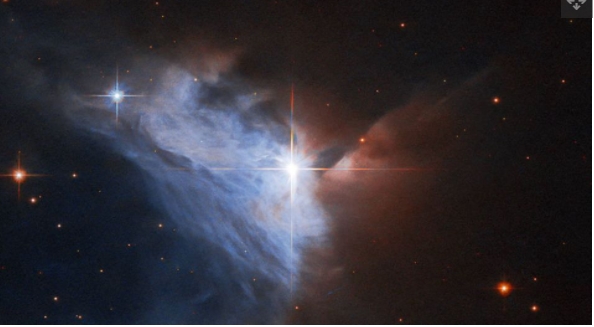Space photos: The most amazing images this week!

China’s first Mars lander snaps its first image from the Red Planet’s surface, an experiment creates colorful clouds over parts of the U.S. East Coast and the Hubble Space Telescope views a faint emission nebula in the constellation Monoceros (the Unicorn). These are some of the top photos this week from Space.com.
Zhurong takes image from Martian surface
This photo is the first color view of Mars from China’s Zhurong rover, looking toward its rear, from its landing spot on a plain in Utopia Planitia following a May 14, 2021 landing. This image was released May 19.
(Image credit: China National Space Administration)
This photo, released on Wednesday (May 19), is the first color view of Mars from China’s Zhurong rover. The probe landed onto the Red Planet’s surface last week (May 14). In this view, the camera is looking toward Zhurong’s rear from its landing spot on a plain in Utopia Planitia. China’s successful Mars landing last week made it the second nation to successfully soft-land on Mars, joining the United States.
Full story: Behold! China unveils 1st Mars photos from Zhurong rover
Colored clouds of an aurora experiment
The KiNET-X experiment created green and violet clouds in the evening sky over parts of the U.S. East Coast.
(Image credit: NASA Wallops/Twitter)
The suborbital launch of the KiNET-X experiment created violet and green clouds in the evening sky over parts of the U.S. East Coast last weekend. The mission launched on Sunday (May 16) from NASA’s Wallops Flight Facility in Virginia to help scientists better understand phenomena like auroras. The experiment released barium vapor clouds into the upper atmosphere, and the colors appeared when sunlight struck the particles.
Full story: NASA rocket launch sparks stunning green and violet clouds in night sky (photos)
Earthly time capsules
The interiors of the zircons are visualized using an specialized electron microscope.
(Image credit: Michael Ackerson/Smithsonian)
These intricate oblongs are the interiors of zircons, the oldest and one of the toughest minerals on Earth. Here they are visualized using a specialized electron microscope. These tiny crystal objects can be more than four billion years old. They can act as time capsules for studying ancient Earth, allowing scientists to peer at the primitive stages of our planet’s formation.
Full story: Earth’s oldest crystals reveal age of plate tectonics
The moon and the Earth
The Earth and moon viewed by Chang’e 5 from Sun-Earth Lagrange point 1.
(Image credit: CNSA/CLEP)
Behold! Earth and the moon, from a long distance away. This view comes from China’s Chang’e 5 probe, which flew to the moon to collect samples and then dropped them off on Earth in December 2020. After this rendezvous with our planet, Chang’e 5 journeyed to its next target: the gravitationally-balanced place called Lagrange Point 1, located about 932,000 miles (1.5 million kilometers) away from Earth. This photo comes from that distant location.
Full story: China’s moon-sampling Chang’e 5 probe beams home eerie images from deep space
Determining the size of a neutron star
Heatwave crushes the Arctic
A neutron star at the center of a supernova explosion can be seen in this composite image consisting of X-ray observations from the NASA Chandra observatory, visible-light measurements from the Very Large Telescope and additional data from the Hubble Space Telescope.
(Image credit: NASA)
This colorful image depicts the supernova E0102 in the Small Magellanic Cloud, located 200,000 light years from Earth. This is a composite image that combines X-ray observations from the NASA Chandra observatory, visible-light measurements from the Very Large Telescope and additional data from the Hubble Space Telescope. Neutron stars, like the one at the center of this supernova, were the focus of recently published research that suggests these superdense stellar corpses are actually larger than previously thought. Scientists came to their conclusions by studying the “skin” of these neutron stars.
Land surface temperatures of more than 85 degrees Fahrenheit (30 degrees Celsius) have been recorded close to the Arctic Circle last week as shown in this image captured by the European Earth-monitoring satellite Sentinel-3.
(Image credit: Copernicus)
Land surface temperatures of more than 85 degrees Fahrenheit (30 degrees Celsius) have been recorded close to the Arctic Circle last week as shown in this image captured by the European Earth-monitoring satellite Sentinel-3 on Thursday (May 13).
Maximum daytime air temperatures soared to 80 degrees F (27 degrees C) in parts of Northwestern Russia around the White Sea, a deviation of 23 to 36 degrees F (13 to 20 degrees C) from the average typical for this period of the year. Last year, the Arctic region experienced months of unusually hot weather. The 2020 heatwave led to destructive wildfires and the second lowest summer sea ice extent on record. Hot summer spells are not unusual in the Arctic. However, according to available data, the region is warming two to three times faster than the global average. — Tereza Pultarova
Hubble spots faint emission nebula
An image of the emission nebula NGC 2313 captured by the Hubble Space Telescope.
(Image credit: ESA/Hubble, R. Sahai)
The bright fluffy cloud in this image captured by the Hubble Space Telescope is the so-called emission nebula NGC 2313. Part of the constellation Monoceros (Greek for Unicorn), the nebula is formed of ionized light-emitting gas centered around the star V565. Some 3,700 light years away from the sun, the nebula, first discovered in 1862, can be found close to the much brighter Orion constellation but is not visible to the naked eye. — Tereza Pultarova
Sun sets above Jezero Crater
A late-afternoon sun above Jezero Crater captured by the NASA Perseverance rover.
(Image credit: NASA/JPL-Caltech)
The Left Navigation Camera (Navcam) of the NASA Perseverance rover captured this image of a late afternoon sun above Jezero Crater at 15:38 pm on May 17, the rover’s 85th sol on Mars. Sol, a Martian day, is about 40 minutes longer than a day on Earth, which means the planets’ times constantly diverge. The two Navcams, located on top of the rover’s mast, help Perseverance drive autonomously and safely avoid obstacles. When not capturing atmospheric sceneries, the Navcams can detect objects as small as a golf ball up to 82 feet (25 meters) away. — Tereza Pultarova
Juno spots new feature in Jupiter’s atmosphere
Clyde’s Spot on Jupiter, as imaged by NASA’s Juno spacecraft in April, 2021.
(Image credit: NASA/JPL-Caltech/SwRI/MSSS Image processing by Kevin M. Gill © CC BY)
NASA’s Juno mission captured images of Clyde’s Spot, a new feature in the atmosphere of Jupiter, first observed last year by an amateur astronomer in South Africa. Named after its discoverer, retired engineer and avid sky-watcher Clyde Foster, the plume of cloud erupting above the gas giant’s atmosphere southeast of the famous Great Red Spot, has undergone substantial changes since its discovery in May last year.
Juno flew over the area during its 33rd close pass on April 15 at a distance of about 16,800 miles (27,000 kilometers) from the top cloud layer. The images, captured by the JunoCam camera, reveal that the remnants of Clyde’s Spot had drifted away from the Great Red Spot and developed into a complex structure that scientists call a folded filamentary region. Twice as wide and three times as long as the original spot, the evolved feature might persist for an extended period of time, the scientists believe. Juno originally observed the spot in June 2020, only two weeks after Foster’s discovery. — Tereza Pultarova
Egypt’s Great Pyramid seen by new very-high resolution satellite
The Great Pyramid of Giza seen in first images captured by the new very-high resolution satellite Pléiades Neo 3 built and operated by European aerospace giant Airbus.
(Image credit: Airbus)
The Great Pyramid of Giza, also known as the Pyramid of Cheops, was captured by the new Pléiades Neo 3 satellite of European aerospace company Airbus. Launched in late April this year, Pléiades Neo 3 sees details as small as 30 cm (1 foot). The image of the 481-foot-high (147.6 m) pyramid was part of the first release of test images taken by the satellite earlier this month. Single limestone blocks that the pyramid is made of can be distinguished in the image as well as individual visitors to the world-famous archeological site on the outskirts of the Egyptian capital Cairo. — Tereza Pultarova



 Creators of mankind
Creators of mankind Description of “Tall white aliens”
Description of “Tall white aliens” Where they came from?
Where they came from? About hostile civilizations
About hostile civilizations The war for the Earth
The war for the Earth “Tall white aliens” about eternal life
“Tall white aliens” about eternal life Video: “Nordic aliens”
Video: “Nordic aliens” Aliens
Aliens Alien encounters
Alien encounters The aliens base
The aliens base UFO
UFO Technology UFO
Technology UFO Underground civilization
Underground civilization Ancient alien artifacts
Ancient alien artifacts Military and UFO
Military and UFO Mysteries and hypotheses
Mysteries and hypotheses Scientific facts
Scientific facts


















